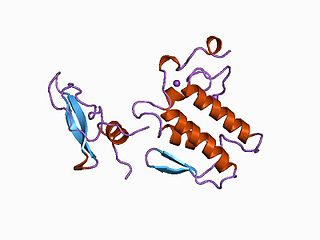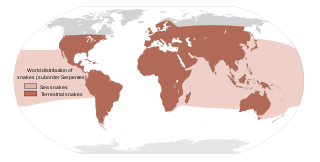Related Research Articles
A toxin is a harmful substance produced within living cells or organisms; synthetic toxicants created by artificial processes are thus excluded. The term was first used by organic chemist Ludwig Brieger (1849–1919), derived from the word toxic.

Venom is a type of poison, especially one secreted by an animal. Venom has evolved in a wide variety of animals, both predators and prey, and both vertebrates and invertebrates.

Francesco Redi was an Italian physician, naturalist, biologist and poet. He is referred to as the "founder of experimental biology", and as the "father of modern parasitology". He was the first person to challenge the theory of spontaneous generation by demonstrating that maggots come from eggs of flies.

Antivenom, also known as antivenin, venom antiserum, and antivenom immunoglobulin, is a specific treatment for envenomation. It is composed of antibodies and used to treat certain venomous bites and stings. Antivenoms are recommended only if there is significant toxicity or a high risk of toxicity. The specific antivenom needed depends on the species involved. It is given by injection.

A snakebite is an injury caused by the bite of a snake, especially a venomous snake. A common sign of a bite from a venomous snake is the presence of two puncture wounds from the animal's fangs. Sometimes venom injection from the bite may occur. This may result in redness, swelling, and severe pain at the area, which may take up to an hour to appear. Vomiting, blurred vision, tingling of the limbs, and sweating may result. Most bites are on the hands, arms, or legs. Fear following a bite is common with symptoms of a racing heart and feeling faint. The venom may cause bleeding, kidney failure, a severe allergic reaction, tissue death around the bite, or breathing problems. Bites may result in the loss of a limb or other chronic problems. The outcome depends on the type of snake, the area of the body bitten, the amount of venom injected, and the general health of the person bitten. Problems are often more severe in children than adults, due to their smaller size.

Russell's viper is a species of venomous snake in the family Viperidae native to the Indian subcontinent. It was described in 1797 by George Shaw and Frederick Polydore Nodder, and named in honour of Patrick Russell who wrote of it in his 1796 work An account of Indian serpents, collected on the coast of Coromandel.
Venomous snakes are species of the suborder Serpentes that are capable of producing venom, which they use for killing prey, for defense, and to assist with digestion of their prey. The venom is typically delivered by injection using hollow or grooved fangs, although some venomous snakes lack well-developed fangs. Common venomous snakes include the families Elapidae, Viperidae, Atractaspididae, and some of the Colubridae. The toxicity of venom is mainly indicated by murine LD50, while multiple factors are considered to judge the potential danger to humans. Other important factors for risk assessment include the likelihood that a snake will bite, the quantity of venom delivered with the bite, the efficiency of the delivery mechanism, and the location of a bite on the body of the victim. Snake venom may have both neurotoxic and hemotoxic properties.

Deinagkistrodon is a monotypic genus created for the venomous pit viper species, D. acutus, which is endemic to Southeast Asia. No subspecies are currently recognized.

Calloselasma is a monotypic genus created for a venomous pit viper species, C. rhodostoma, which is endemic to Southeast Asia from Thailand to northern Malaysia and on the island of Java. No subspecies are currently recognized.

Venomous fish are species of fish which produce strong mixtures of toxins harmful to humans which they deliberately deliver by means of a bite, sting, or stab, resulting in an envenomation. As a contrast, poisonous fish also produce a strong toxin, but they do not bite, sting, or stab to deliver the toxin, instead being poisonous to eat because the human digestive system does not destroy the toxin they contain in their bodies. Venomous fish do not necessarily cause poisoning if they are eaten, as the digestive system often destroys the venom.
Tityustoxin is a toxin found in the venom of scorpions from the subfamily Tityinae. By binding to voltage-dependent sodium ion channels and potassium channels, they cause sialorrhea, lacrimation and rhinorrhea.

Nodularins are potent toxins produced by the cyanobacterium Nodularia spumigena. This aquatic, photosynthetic cyanobacterium forms visible colonies that present as algal blooms in brackish water bodies throughout the world. The late summer blooms of Nodularia spumigena are among the largest cyanobacterial mass occurrences in the world. Cyanobacteria are composed of many toxic substances, most notably of microcystins and nodularins: the two are not easily differentiated. A significant homology of structure and function exists between the two, and microcystins have been studied in greater detail. Because of this, facts from microcystins are often extended to nodularins.

β-Bungarotoxin is a form of bungarotoxin that is fairly common in Krait venoms. It is the prototypic class of snake β-neurotoxins. There are at least five isoforms, coded β1 to β5, assembled from different combinations of A and Bchains.
Birtoxin is a neurotoxin from the venom of the South African Spitting scorpion. By changing sodium channel activation, the toxin promotes spontaneous and repetitive firing much like pyrethroid insecticides do
Bestoxin is a neurotoxin from the venom of the South African spitting scorpion Parabuthus transvaalicus. Most likely, it targets sodium channel function, thus promoting spontaneous and repetitive neuronal firing. Following injection into mice, it causes non-lethal writhing behaviour.

Most snakebites are caused by non-venomous snakes. Of the roughly 3,700 known species of snake found worldwide, only 15% are considered dangerous to humans. Snakes are found on every continent except Antarctica. There are two major families of venomous snakes, Elapidae and Viperidae. Three hundred twenty five species in 61 genera are recognized in the family Elapidae and 224 species in 22 genera are recognized in the family Viperidae, In addition, the most diverse and widely distributed snake family, the colubrids, has approximately 700 venomous species, but only five genera—boomslangs, twig snakes, keelback snakes, green snakes, and slender snakes—have caused human fatalities.
Redi Award is an international science award given to scientists who have made significant contributions in toxinology, the scientific study of venoms, poisons and toxins. The award is sponsored by the International Society on Toxinology (ISI).

The North American Society of Toxinology (NAST) is a North America-based, international, multidisciplinary organization dedicated to the advancement of the science of all things venomous. It was founded in 2012 and is a 501(c)(3) organization under the U.S. Internal Revenue Service.
Whole blood clotting test (WBCT) a blood test used to check the coagulation mechanism in the blood following a snake bite. If the test is positive after a bite in South East Asia it indicates the snake was a viper rather than an elapid.
References
- 1 2 3 Mebs D (2012). "History of the International Society on Toxinology - A personal view". Toxicon. 69: 21–8. doi:10.1016/j.toxicon.2012.11.021. PMID 23237723.
- ↑ Francesco Redi (1988). Knoefel PK (ed.). Francesco Redi on Vipers. Leiden, the Netherlands: E.J. Brill. pp. 11–17. ISBN 9004089489 . Retrieved 2013-04-18.
- 1 2 Habermehl GG (1994). "Francesco Redi—life and work". Toxicon. 32 (4): 411–417. doi:10.1016/0041-0101(94)90292-5. PMID 8052995.
- ↑ Hayes AN, Gilbert SG (2009). "Historical milestones and discoveries that shaped the toxicology sciences". EXS. 99 (1): 1–35. doi:10.1007/978-3-7643-8336-7_1. PMID 19157056.
- ↑ Russell FE (1987). "History of the International Society on Toxinology and Toxicon. I. The formative years, 1954–1965". Toxicon. 25 (1): 3–21. doi:10.1016/0041-0101(87)90148-6. PMID 3551198.
- ↑ International Society on Toxinology. "IST Redi Awards". Archived from the original on 2013-10-04. Retrieved 2013-04-18.
- ↑ WHO. "Neglected tropical diseases: Snakebite" . Retrieved 2013-04-18.
- ↑ Rosenberg P (1987). "Happy 25th birthday Toxicon". Toxicon. 25 (1): 1–2. doi:10.1016/0041-0101(87)90147-4.
- ↑ NCBI NLM Catalogue. "Toxicon" . Retrieved 2013-04-18.